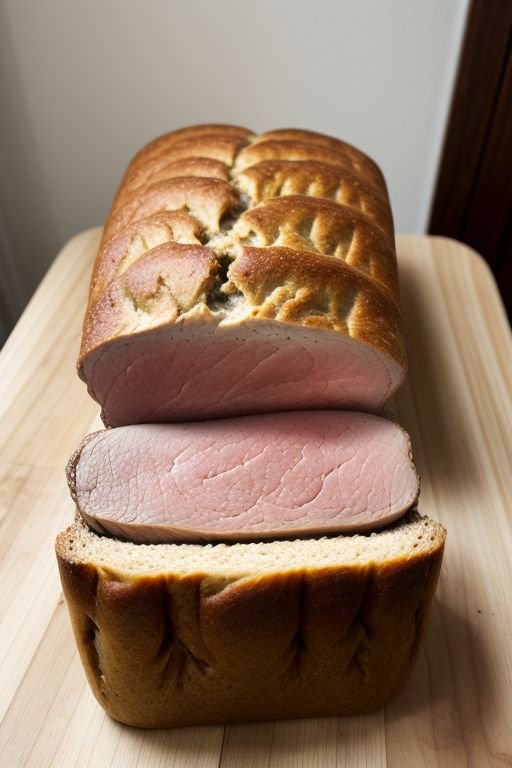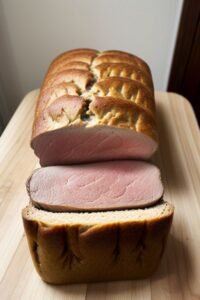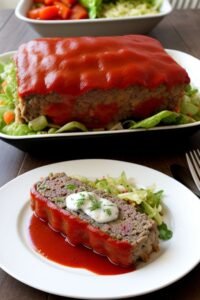What is the meaning of loaf of meat? Meatloaf is a key item in comfort food menus, beloved across many homes. It’s more than just a dish; it’s a culinary artifact. It has evolved over time and across cultures. Traditionally, meatloaf combines ground meat with breadcrumbs, onions, and eggs. It is seasoned with spices, shaped into a loaf, and baked. This dish’s versatility lets it include various meats and sides. It’s favored for its easy preparation and comforting nature.
Understanding What is the meaning of loaf of meat?
At its core, meatloaf is about simplicity and economy. It originated as a way to stretch scarce meat supplies and has been documented in culinary history as far back as the fifth century in Europe. The modern American version that we are familiar with took shape in the late 19th century, with the advent of commercial meat grinders and the publication of recipes in cookbooks. Meatloaf has since become a beloved mainstay in American cuisine, embodying the essence of home-cooked comfort.
Historical Context and Evolution
The history of meatloaf is intertwined with the history of meat consumption and culinary innovation. In ancient times, Roman cooks mixed chopped meat with bread and wine to form patties. This concept was adapted by European chefs who included fruits, nuts, and seasonings. In America, meatloaf became a Depression-era fixture, as families looked to extend their meals with affordable ingredients. Over the decades, it has seen various iterations, from the bacon-wrapped loaves of the 1950s to healthier versions that incorporate turkey or lentils. Each change reflects the economic, social, and cultural shifts of the time.
This introduction sets the stage for a deeper exploration into meatloaf’s culinary significance, its role in cultural traditions, and its evolution into the dish cherished in many kitchens today.
What is Meatloaf?
Meatloaf is more than just a simple dish; it’s a culinary canvas. Cooks can experiment with ingredients and techniques to create a hearty meal. This traditional dish is known mainly in the U.S. but varies globally. It consists of ground meat shaped into a loaf and baked or smoked. Meatloaf is a prime example of home-style cooking. It connects generations with its comforting presence at dinner tables.
Definition from Culinary Perspective
From a culinary standpoint, meatloaf is defined as a dish made from ground meat—commonly beef, pork, lamb, or poultry—combined with various mix-ins and binders such as breadcrumbs, minced onion, eggs, and herbs. The mixture is then formed into the shape of a bread loaf, hence the name, and baked. This method of cooking not only allows for the flavors to meld together but also results in a moist, tender loaf when done correctly. Meatloaf is traditionally served sliced, often accompanied by a ketchup or brown sauce glaze applied during or after baking to add a tangy or sweet finish to the savory meat.
Ingredients and Variations
The basic ingredients of meatloaf are straightforward, yet it is the variations that give this dish its universal appeal. The choice of meat plays a significant role in the texture and flavor of the final product. While beef is commonly used for its rich flavor, mixing pork or veal can add tenderness and juiciness. Poultry, such as ground turkey or chicken, is often used as a leaner alternative, appealing to health-conscious diners.
Beyond the meat, aromatics and additives like onions, garlic, bell peppers, and carrots are often sautéed and added to the mixture for depth of flavor. Herbs and spices such as parsley, thyme, and black pepper are typical seasonings that enhance the meaty base. For the binder, breadcrumbs soaked in milk or broth are preferred for their ability to keep the loaf moist. Some recipes call for a touch of creativity, incorporating ingredients like diced hard-boiled eggs, cheese, or even leftover vegetables.
Global variations of meatloaf reflect local tastes and ingredients. In Italy, a version called « polpettone » might include parmesan cheese and cured meats, whereas in the Middle East, a « kafta » loaf may feature lamb and spices like cumin and coriander. These variations not only demonstrate meatloaf’s versatility but also its ability to adapt to different cultural palates.
Understanding the ingredients and techniques behind meatloaf allows cooks to appreciate its flexibility and to experiment with creating their versions, tailored to personal tastes or dietary needs. This adaptability ensures that meatloaf remains a beloved dish in many cultures, continually evolving with each iteration.



